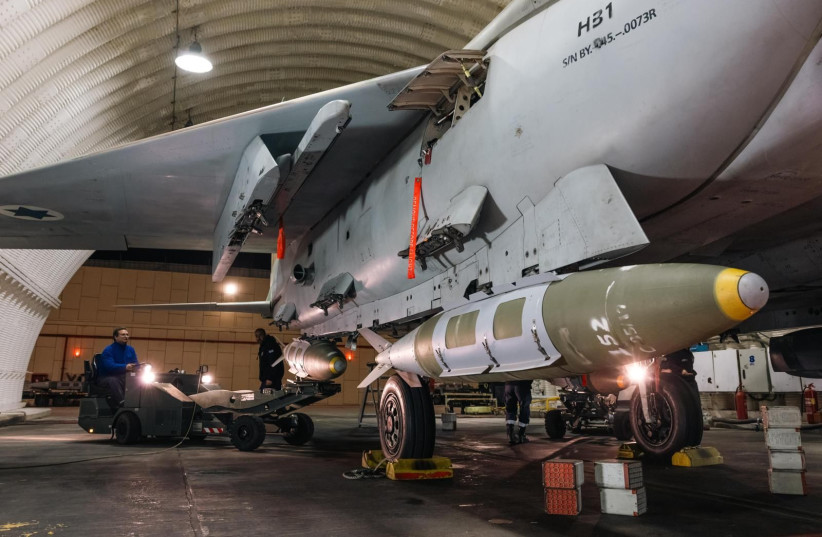IAF pilot to 'Post': Defense op was most meaningful flight of my career
At approximately 10 p.m. on Saturday night, N and his fellow pilots were alerted that it was time to take to the skies.
 | |||
| N AND his copilot prepare their aircraft for takeoff. N was an active member of Israel’s defense systems that were activated Saturday night when Iran targeted Israel with hundreds of drones and missiles. |
“This past Saturday, I flew on the most meaningful flight I have ever made,” Maj. N, an Israel Air Force (IAF) pilot in Squadron 122 who has been on reserve duty since October 7, told The Jerusalem Post on Monday.
He was referring, of course, to Israel’s broad defense operation amid the multifaceted airstrikes launched by the Islamic Regime, titled Iron Shield.
While N was faced with disappointment on Friday when he told his wife that he would not be coming home that night – or that entire weekend, for that matter – he was filled with both “excitement” and “focus,” once he was briefed on the historic operation he would be partaking in.
The IDF – and, indeed, the world – understood quite early on that an Iranian attack was imminent. Israel’s defense systems needed only to be prepared.
At approximately 10 p.m. on Saturday night, N and his fellow pilots were alerted that it was time to take to the skies.

“I’ve been a pilot for over 20 years, and I have participated in many operations, both in and out of Israel. This was the most meaningful flight [yet],” he said. “Since October 7, we, like all of the air force, moved to the highest alertness level, whether it be relating to Gaza or further threats.”
That night, Israel deployed Eitam, Shavit, and Oron aircraft to detect, report, and ultimately help remove airborne threats.
Eitams are Airborne Warning and Control System (AWACS) surveillance planes outfitted with more than $100 million worth of radar and command-and-control systems.
Shavits are intelligence-gathering planes with high altitudes, long flight ranges, and advanced system capabilities. They can detect the operation of electronic systems hundreds of kilometers away and in remote areas.
Orons are high-performance, low-maintenance aircraft equipped with advanced radar and intelligence systems that create real-time, comprehensive intelligence images. This was the type of aircraft N flew on Saturday night.
“We worked to recognize the threats and let the [Operations Division] and the fighter pilots know what the biggest threats were,” N explained. “The controllers in the back speak with the fighter pilots.
'It was like a computer game'
“We were in a very strategic location in the middle of the sky. We were the first to recognize and see what was coming. It was like a computer game.

“I told them, ‘This target is on its way. We need to down this,’” he continued. “You suddenly realize, ‘My god, what am I doing? I cannot mess this up.’ Luckily, our team of controllers are such professionals. We passed messages on to them. It was excellent cooperation.”
According to him, without the work his squadron did, “some of the threats would have reached Israel, God forbid.”
Indeed, IDF Spokesperson R.-Adm. Daniel Hagari revealed, following the operation, that 99% of the aerial threats were shot down, and none of the 200 drones and 30 cruise missiles dispatched got through to Israeli territory at all.
The intel gathered by N and his teammates was ultimately the information that allowed aircraft, David’s Sling, or the Arrow missile systems to down the looming airborne threats. The Iron Dome, which defends well against Hamas and Hezbollah’s simple rockets, is less relevant for drones and fancier long-range missiles.
N, when asked how he felt after the operation, said that he was not able to sleep for days after.
“Only now, three days later, do I understand what I experienced there,” he said. “I experienced what it was like to participate in something far bigger than myself. I needed to protect the country in the most pure place physically. I feel that this was very meaningful and that I physically safeguarded Israel from the 60 tons of weapons.”
After they all landed safely, the pilots and controllers, along with their commanders, met for a debriefing, as the Air Force does regularly.
“A truly honest debriefing is central to us,” N said. “We are always looking to improve. We are ready for any threat. We are always practicing, always sharpening our knives.
“Not for a single moment do we forget the hostages,” N concluded tearfully. “Our main goal is to return them. I wish only for freedom for our hostages, that they return healthy and well, and that all the soldiers, reservists or not, come back home, amen.”
Squadron 122 was, as N described it, an “irreplaceable and crucial part of this operation.”
https://www.jpost.com/israel-news/defense-news/article-797337?
No comments:
Post a Comment